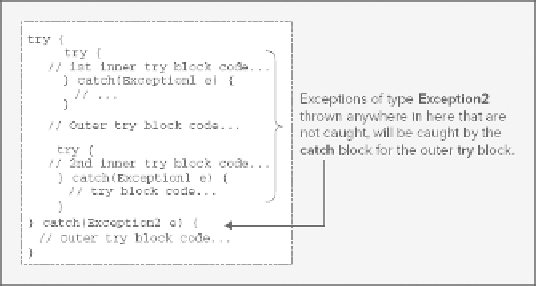Java Reference
In-Depth Information
The
catch
blocks for the outer
try
block can catch any exceptions that are thrown, but not caught, by
any code within the block, including code within inner
try
-
catch
blocks. In the example shown in
Figure
7-6
,
the
catch
block for the outer
try
block catches any exception of type
Exception2
. Such exceptions
could originate anywhere within the outer
try
block. The illustration shows two levels of nesting, but you
can specify more if you know what you're doing.
Rethrowing Exceptions
Even though you may need to recognize that an exception has occurred in a method by implementing a
catch
clause for it, this is not necessarily the end of the matter. In many situations, the calling program may
need to know about it — perhaps because it affects the continued operation of the program or because the
calling program may be able to compensate for the problem.
If you need to pass an exception that you have caught on to the calling program, you can rethrow it from
within the
catch
block using a
throw
statement. For example:
try {
// Code that originates an arithmetic exception
} catch(ArithmeticException e) {
// Deal with the exception here
throw e; // Rethrow the exception to the calling program
}
The
throw
statement is the keyword
throw
followed by the exception object to be thrown. When you
look at how to define your own exceptions later in this chapter, you use exactly the same mechanism to
throw them.
EXCEPTION OBJECTS
Well, you now understand how to put
try
blocks together with
catch
blocks and
finally
blocks in your
methods. You may be thinking at this point that it seems a lot of trouble to go to just to display a message
when an exception is thrown. You may be right, but whether you can do so very much more depends on the
nature and context of the problem. In many situations a message may be the best you can do, although you

